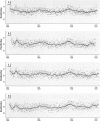Abstract
A component of particulate matter (PM) air pollution that may provide one biologically plausible pathway for the observed PM air pollution-health effect associations is aerosol acidity (H(+)). An increasing number of observational studies have demonstrated associations between H(+) and increased adverse health effects in the United States and abroad. Although studies have shown significant H(+) associations with increased morbidity in the United States, similar associations have yet to be shown with daily mortality. We considered a 2.5-year record of daily H(+) and sulfate measurements (May 1988-October 1990) collected in the Buffalo, New York, region in a time-series analysis of respiratory, circulatory, and total daily mortality and hospital admissions. Other copollutants considered included particulate matter [less than/equal to] 10 microm in aerodynamic diameter, coefficient of haze, ozone, carbon monoxide, sulfur dioxide, and nitrogen dioxide. Various modeling techniques were applied to control for confounding of effect estimates due to seasonality, weather, and day-of-week effects. We found multiple significant pollutant-health effect associations--most strongly between SO(4)(2-) and respiratory hospital admissions (as indicated by its t-statistic). Additionally, H(+) and SO(4)(2-) demonstrated the most coherent associations with both respiratory hospital admissions [H(+): relative risk (RR) = 1. 31; 95% confidence interval (CI), 1.14-1.51; and SO(4)(2-): RR = 1. 18, CI, 1.09-1.28] and respiratory mortality (H(+): RR = 1.55, CI, 1. 09-2.20; and SO(4)(2-): RR = 1.24, CI, 1.01-1.52). Thus, acidic sulfate aerosols represent a component of PM air pollution that may contribute to the previously noted adverse effects of PM mass on human health, and the associations demonstrated in this study support the need for further investigations into the potential health effects of acidic aerosols.
Full text
PDF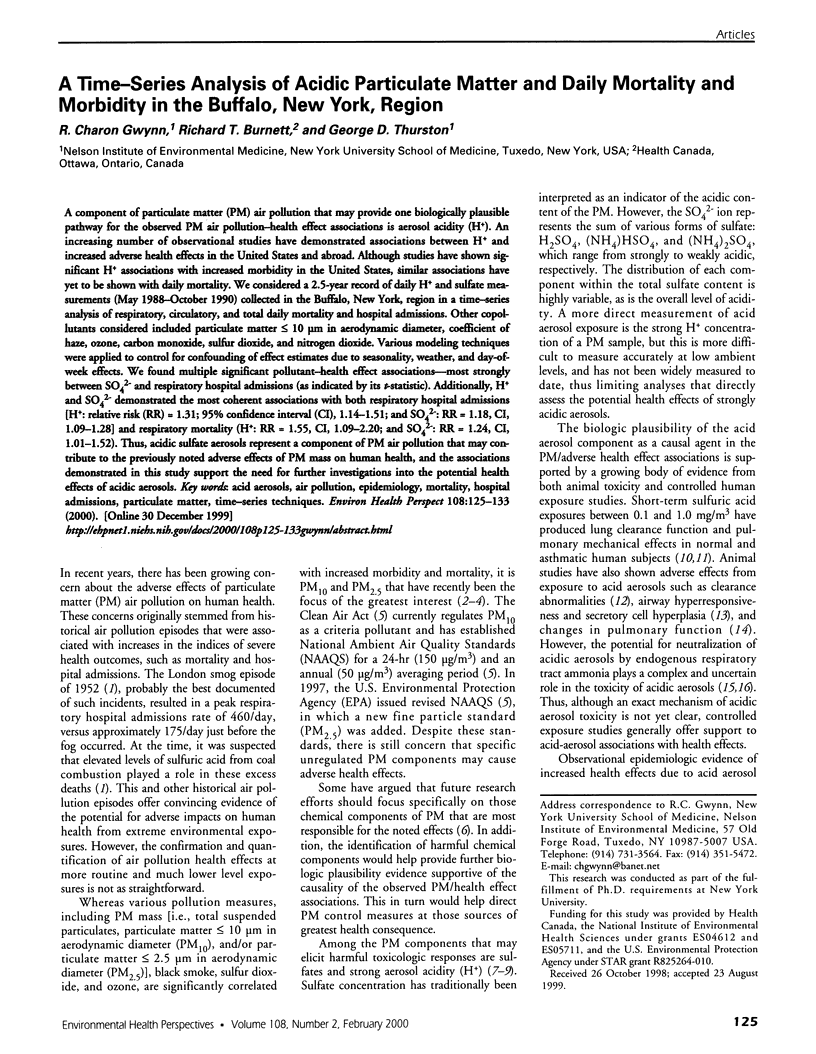
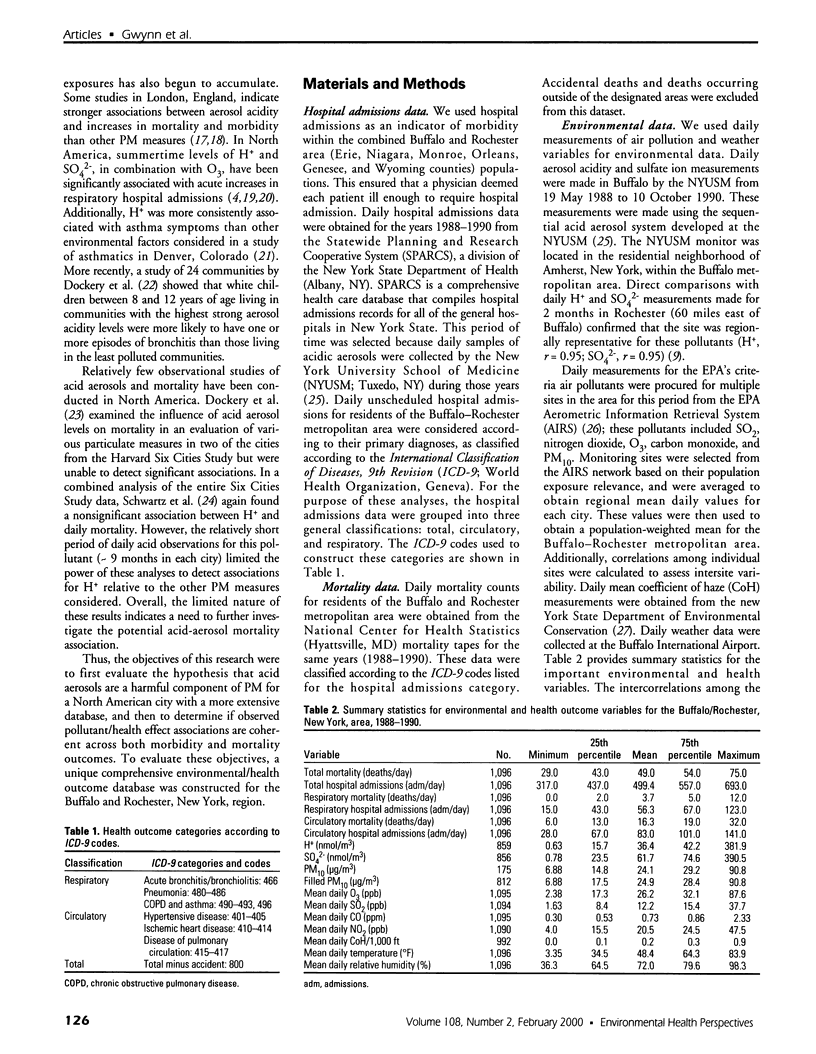
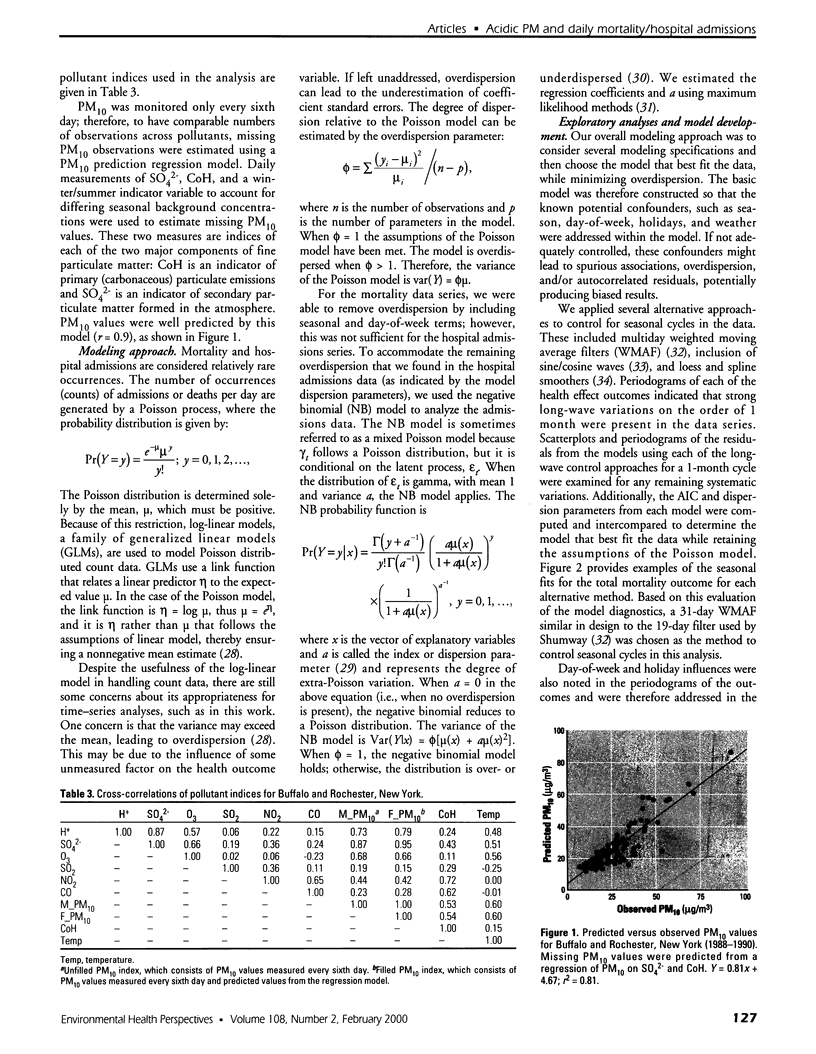
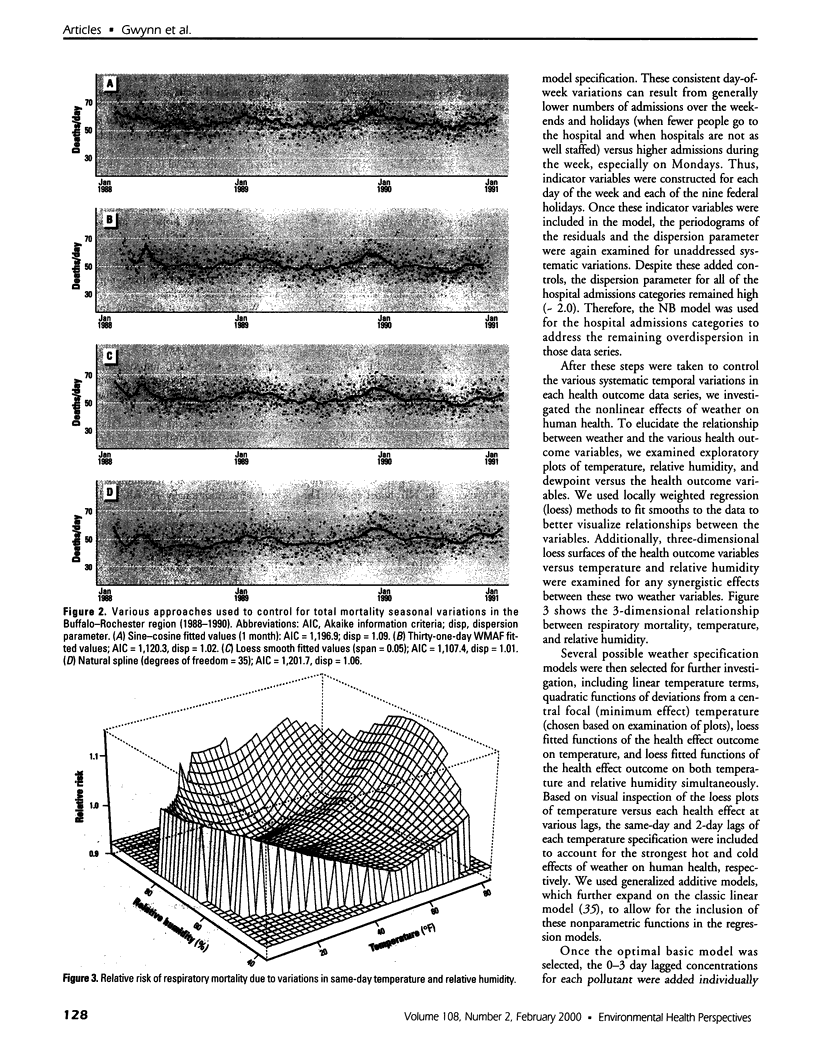
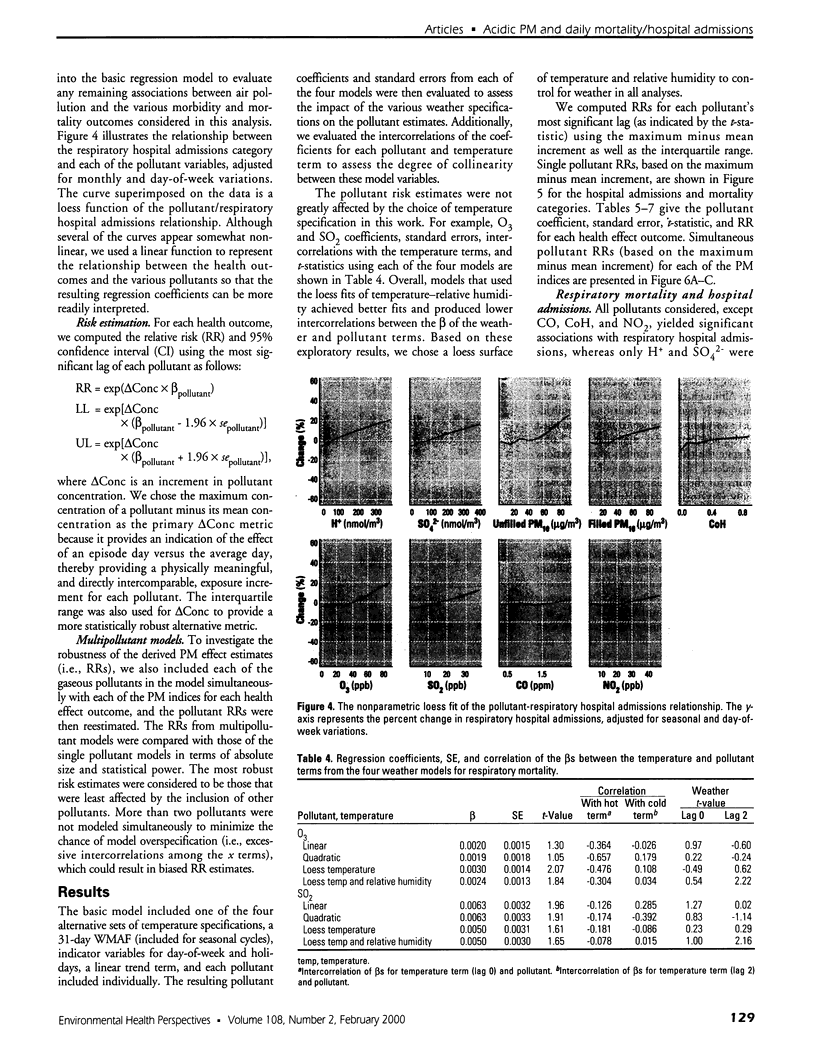
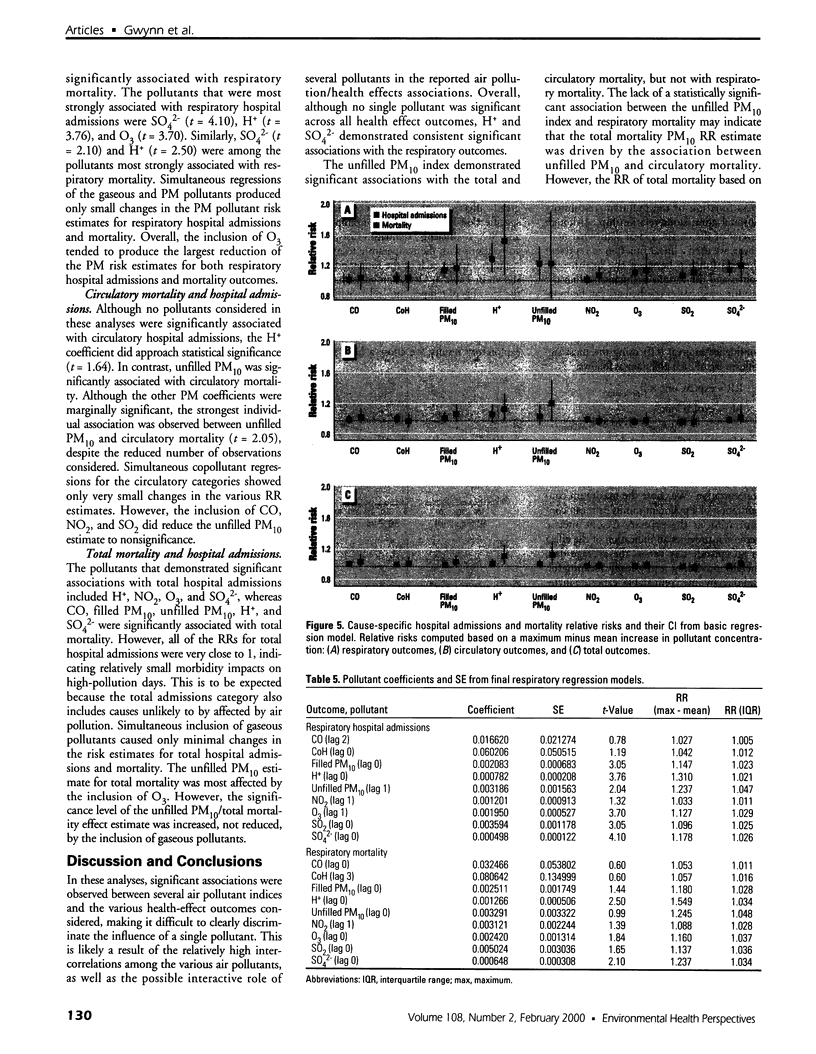
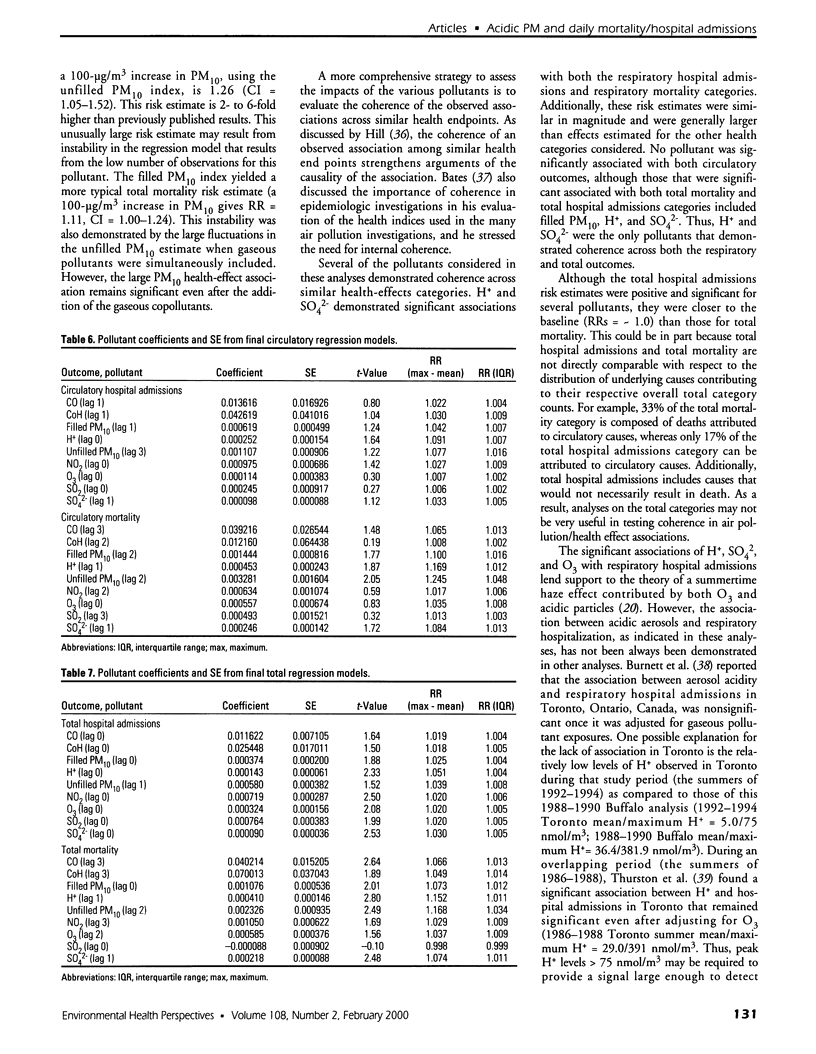
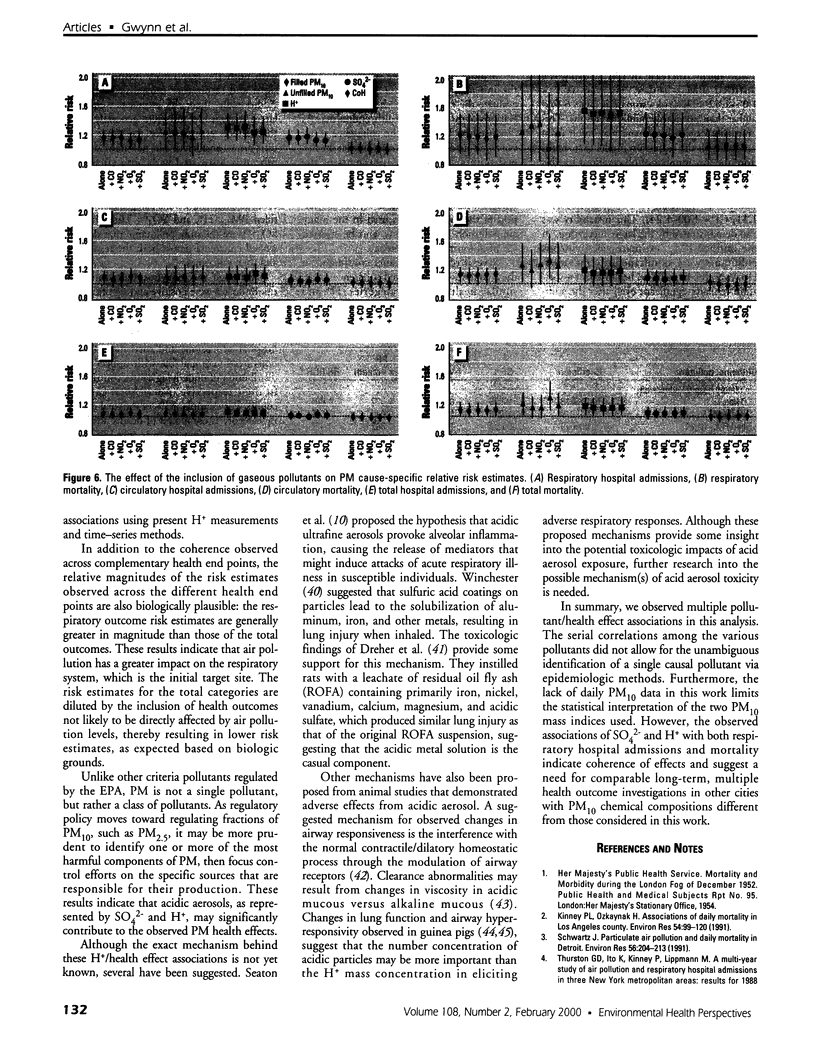
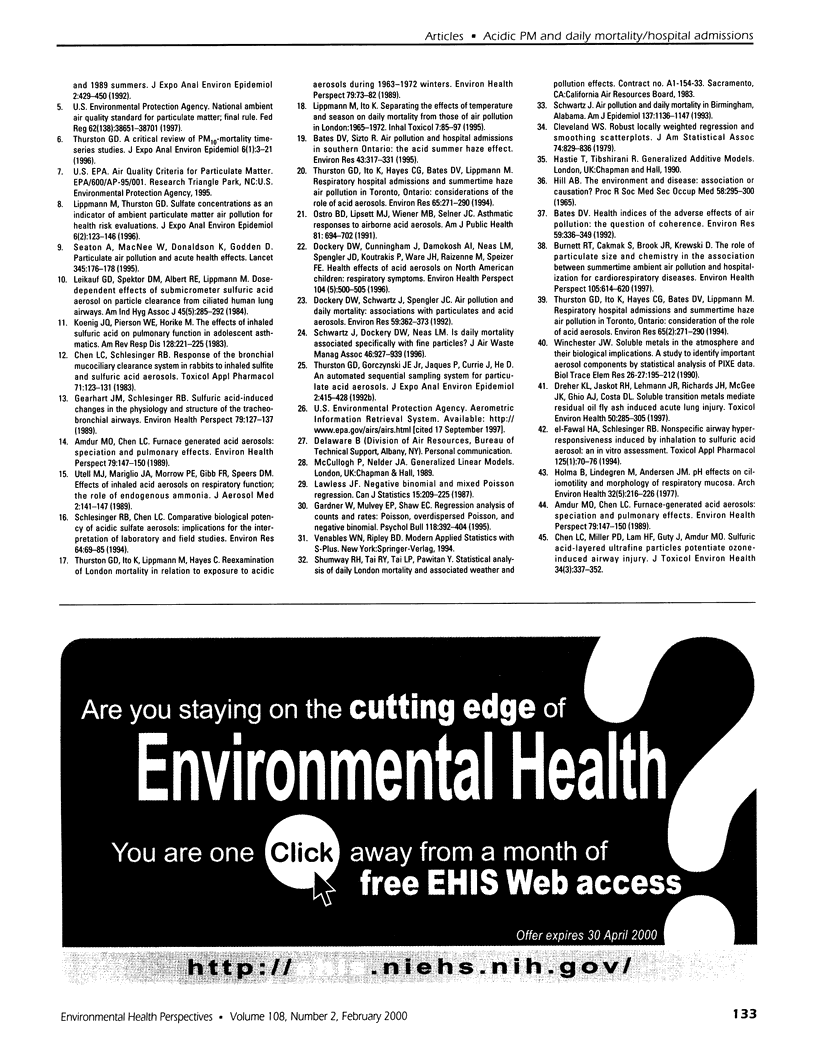
Images in this article
Selected References
These references are in PubMed. This may not be the complete list of references from this article.
- Amdur M. O., Chen L. C. Furnace-generated acid aerosols: speciation and pulmonary effects. Environ Health Perspect. 1989 Feb;79:147–150. doi: 10.1289/ehp.8979147. [DOI] [PMC free article] [PubMed] [Google Scholar]
- Amdur M. O., Chen L. C. Furnace-generated acid aerosols: speciation and pulmonary effects. Environ Health Perspect. 1989 Feb;79:147–150. doi: 10.1289/ehp.8979147. [DOI] [PMC free article] [PubMed] [Google Scholar]
- Bates D. V. Health indices of the adverse effects of air pollution: the question of coherence. Environ Res. 1992 Dec;59(2):336–349. doi: 10.1016/s0013-9351(05)80040-4. [DOI] [PubMed] [Google Scholar]
- Bates D. V., Sizto R. Air pollution and hospital admissions in Southern Ontario: the acid summer haze effect. Environ Res. 1987 Aug;43(2):317–331. doi: 10.1016/s0013-9351(87)80032-4. [DOI] [PubMed] [Google Scholar]
- Burnett R. T., Cakmak S., Brook J. R., Krewski D. The role of particulate size and chemistry in the association between summertime ambient air pollution and hospitalization for cardiorespiratory diseases. Environ Health Perspect. 1997 Jun;105(6):614–620. doi: 10.1289/ehp.97105614. [DOI] [PMC free article] [PubMed] [Google Scholar]
- Chen L. C., Miller P. D., Lam H. F., Guty J., Amdur M. O. Sulfuric acid-layered ultrafine particles potentiate ozone-induced airway injury. J Toxicol Environ Health. 1991 Nov;34(3):337–352. doi: 10.1080/15287399109531572. [DOI] [PubMed] [Google Scholar]
- Chen L. C., Schlesinger R. B. Response of the bronchial mucociliary clearance system in rabbits to inhaled sulfite and sulfuric acid aerosols. Toxicol Appl Pharmacol. 1983 Oct;71(1):123–131. doi: 10.1016/0041-008x(83)90051-0. [DOI] [PubMed] [Google Scholar]
- Dockery D. W., Cunningham J., Damokosh A. I., Neas L. M., Spengler J. D., Koutrakis P., Ware J. H., Raizenne M., Speizer F. E. Health effects of acid aerosols on North American children: respiratory symptoms. Environ Health Perspect. 1996 May;104(5):500–505. doi: 10.1289/ehp.96104500. [DOI] [PMC free article] [PubMed] [Google Scholar]
- Dockery D. W., Schwartz J., Spengler J. D. Air pollution and daily mortality: associations with particulates and acid aerosols. Environ Res. 1992 Dec;59(2):362–373. doi: 10.1016/s0013-9351(05)80042-8. [DOI] [PubMed] [Google Scholar]
- Dreher K. L., Jaskot R. H., Lehmann J. R., Richards J. H., McGee J. K., Ghio A. J., Costa D. L. Soluble transition metals mediate residual oil fly ash induced acute lung injury. J Toxicol Environ Health. 1997 Feb 21;50(3):285–305. [PubMed] [Google Scholar]
- Gardner W., Mulvey E. P., Shaw E. C. Regression analyses of counts and rates: Poisson, overdispersed Poisson, and negative binomial models. Psychol Bull. 1995 Nov;118(3):392–404. doi: 10.1037/0033-2909.118.3.392. [DOI] [PubMed] [Google Scholar]
- Gearhart J. M., Schlesinger R. B. Sulfuric acid-induced changes in the physiology and structure of the tracheobronchial airways. Environ Health Perspect. 1989 Feb;79:127–136. doi: 10.1289/ehp.8979127. [DOI] [PMC free article] [PubMed] [Google Scholar]
- HILL A. B. THE ENVIRONMENT AND DISEASE: ASSOCIATION OR CAUSATION? Proc R Soc Med. 1965 May;58:295–300. [PMC free article] [PubMed] [Google Scholar]
- Holma B., Lindegren M., Andersen J. M. pH effects on ciliomotility and morphology of respiratory mucosa. Arch Environ Health. 1977 Sep-Oct;32(5):216–226. doi: 10.1080/00039896.1977.10667285. [DOI] [PubMed] [Google Scholar]
- Kinney P. L., Ozkaynak H. Associations of daily mortality and air pollution in Los Angeles County. Environ Res. 1991 Apr;54(2):99–120. doi: 10.1016/s0013-9351(05)80094-5. [DOI] [PubMed] [Google Scholar]
- Koenig J. Q., Pierson W. E., Horike M. The effects of inhaled sulfuric acid on pulmonary function in adolescent asthmatics. Am Rev Respir Dis. 1983 Aug;128(2):221–225. doi: 10.1164/arrd.1983.128.2.221. [DOI] [PubMed] [Google Scholar]
- Leikauf G. D., Spektor D. M., Albert R. E., Lippmann M. Dose-dependent effects of submicrometer sulfuric acid aerosol on particle clearance from ciliated human lung airways. Am Ind Hyg Assoc J. 1984 May;45(5):285–292. doi: 10.1080/15298668491399802. [DOI] [PubMed] [Google Scholar]
- Lippmann M., Thurston G. D. Sulfate concentrations as an indicator of ambient particulate matter air pollution for health risk evaluations. J Expo Anal Environ Epidemiol. 1996 Apr-Jun;6(2):123–146. [PubMed] [Google Scholar]
- Ostro B. D., Lipsett M. J., Wiener M. B., Selner J. C. Asthmatic responses to airborne acid aerosols. Am J Public Health. 1991 Jun;81(6):694–702. doi: 10.2105/ajph.81.6.694. [DOI] [PMC free article] [PubMed] [Google Scholar]
- Schlesinger R. B., Chen L. C. Comparative biological potency of acidic sulfate aerosols: implications for the interpretation of laboratory and field studies. Environ Res. 1994 Apr;65(1):69–85. doi: 10.1006/enrs.1994.1022. [DOI] [PubMed] [Google Scholar]
- Schwartz J. Air pollution and daily mortality in Birmingham, Alabama. Am J Epidemiol. 1993 May 15;137(10):1136–1147. doi: 10.1093/oxfordjournals.aje.a116617. [DOI] [PubMed] [Google Scholar]
- Schwartz J., Dockery D. W., Neas L. M. Is daily mortality associated specifically with fine particles? J Air Waste Manag Assoc. 1996 Oct;46(10):927–939. [PubMed] [Google Scholar]
- Schwartz J. Particulate air pollution and daily mortality in Detroit. Environ Res. 1991 Dec;56(2):204–213. doi: 10.1016/s0013-9351(05)80009-x. [DOI] [PubMed] [Google Scholar]
- Seaton A., MacNee W., Donaldson K., Godden D. Particulate air pollution and acute health effects. Lancet. 1995 Jan 21;345(8943):176–178. doi: 10.1016/s0140-6736(95)90173-6. [DOI] [PubMed] [Google Scholar]
- Thurston G. D. A critical review of PM10-mortality time-series studies. J Expo Anal Environ Epidemiol. 1996 Jan-Mar;6(1):3–21. [PubMed] [Google Scholar]
- Thurston G. D., Gorczynski J. E., Jr, Jaques P., Currie J., He D. An automated sequential sampling system for particulate acid aerosols: description, characterization, and field sampling results. J Expo Anal Environ Epidemiol. 1992 Oct-Dec;2(4):415–428. [PubMed] [Google Scholar]
- Thurston G. D., Ito K., Hayes C. G., Bates D. V., Lippmann M. Respiratory hospital admissions and summertime haze air pollution in Toronto, Ontario: consideration of the role of acid aerosols. Environ Res. 1994 May;65(2):271–290. doi: 10.1006/enrs.1994.1037. [DOI] [PubMed] [Google Scholar]
- Thurston G. D., Ito K., Hayes C. G., Bates D. V., Lippmann M. Respiratory hospital admissions and summertime haze air pollution in Toronto, Ontario: consideration of the role of acid aerosols. Environ Res. 1994 May;65(2):271–290. doi: 10.1006/enrs.1994.1037. [DOI] [PubMed] [Google Scholar]
- Thurston G. D., Ito K., Lippmann M., Hayes C. Reexamination of London, England, mortality in relation to exposure to acidic aerosols during 1963-1972 winters. Environ Health Perspect. 1989 Feb;79:73–82. doi: 10.1289/ehp.897973. [DOI] [PMC free article] [PubMed] [Google Scholar]
- Winchester J. W. Soluble metals in the atmosphere and their biological implications. A study to identify important aerosol components by statistical analysis of PIXE data. Biol Trace Elem Res. 1990 Jul-Dec;26-27:195–212. doi: 10.1007/BF02992673. [DOI] [PubMed] [Google Scholar]
- el-Fawal H. A., Schlesinger R. B. Nonspecific airway hyperresponsiveness induced by inhalation exposure to sulfuric acid aerosol: an in vitro assessment. Toxicol Appl Pharmacol. 1994 Mar;125(1):70–76. doi: 10.1006/taap.1994.1050. [DOI] [PubMed] [Google Scholar]




